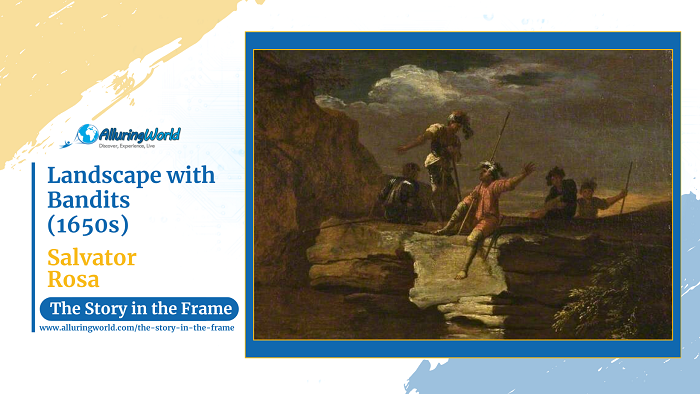Painted in the 17th century, Landscape with Bandits is a dramatic and atmospheric work completed by the artist Salvator Rosa who was known for his wild, untamed landscapes and rebellious artistic spirit. This painting exemplifies his fascination with rugged nature, banditry, and themes of danger and mystery, and Rosa’s landscapes often stood apart from the idyllic scenes popular in his time, embracing a darker, more theatrical mood that would later influence Romanticism.
About the Painter:
Salvator Rosa (1615–1673) was an Italian Baroque painter, poet, and printmaker, celebrated for his unconventional approach to both art and life. Born in Naples, he rejected the idealized classical landscapes of his contemporaries, instead depicting stormy, dramatic scenes filled with outlaws, hermits, and soldiers. His rebellious personality extended beyond painting, as he also wrote satirical poetry that criticized the artistic establishment. His work was highly influential, inspiring later painters such as Francisco Goya and Romantic landscape artists.
Inspiration and Reasons Behind the Painting:
Rosa was deeply inspired by the harsh, untamed landscapes of southern Italy, particularly the mountainous regions that harbored bandits and exiles, and unlike traditional pastoral landscapes, which depicted harmonious nature, Rosa sought to portray the wilderness as a place of both beauty and peril. His fascination with outlaws and antiheroes reflected his own defiant spirit, and Landscape with Bandits serves as a visual narrative of lawlessness, survival, and the untamed forces of nature, so this painting likely resonated with audiences who were captivated by stories of brigands and the dangers lurking in remote landscapes.
What is Depicted in the Painting:
The composition presents a rugged, mountainous terrain under a stormy sky, where a group of bandits gathers in a tense moment. Some figures appear to be planning an ambush, while others engage in conversation, and their postures suggest both vigilance and camaraderie. The jagged cliffs, windswept trees, and dramatic lighting heighten the sense of unease, creating a stage-like setting for the unfolding scene. Rosa’s mastery of storytelling is evident, as the viewer is drawn into the mystery of the figures, and the viewer is wondering: are they awaiting their next victim, or retreating after a successful raid? The absence of ruins or a distant, foreboding structure adds to the sense of isolation and lawlessness.
Colors and Techniques:
Rosa’s palette in Landscape with Bandits is dominated by earthy browns, deep greens, and stormy grays, creating a brooding atmosphere. His use of strong contrasts between light and shadow, known as chiaroscuro, enhances the painting’s drama, making the figures and landscape appear almost sculptural. The expressive, loose brushwork captures the raw energy of nature, emphasizing the rugged terrain and turbulent sky. His ability to blend landscape with narrative makes the scene feel both naturalistic and cinematic, immersing the viewer in its dramatic tension.
Conclusion:
Overall, Landscape with Bandits is a prime example of Salvator Rosa’s unique artistic vision, challenging the conventions of landscape painting in his time. His depiction of wild nature and lawless figures speaks to themes of freedom, danger, and defiance, making his work a precursor to the Romantic fascination with the sublime. Today, Rosa’s landscapes continue to inspire artists and audiences alike, celebrated for their raw emotion, dramatic storytelling, and rebellious spirit.

